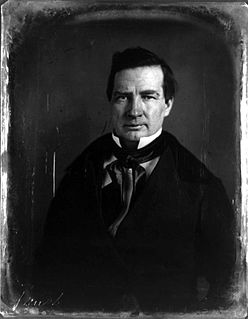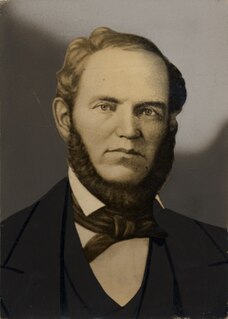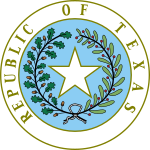
The Republic of Texas was a sovereign state in North America that existed from March 2, 1836, to February 19, 1846, although Mexico considered it a rebellious province during its entire existence. It was bordered by Mexico to the west and southwest, the Gulf of Mexico to the southeast, the two U.S. states of Louisiana and Arkansas to the east and northeast, and United States territories encompassing parts of the current U.S. states of Oklahoma, Kansas, Colorado, Wyoming, and New Mexico to the north and west. The Anglo residents of the republic were known as Texians.

Thomas Jefferson Rusk was an early political and military leader of the Republic of Texas, serving as its first Secretary of War as well as a general at the Battle of San Jacinto. He was later a US politician and served as a Senator from Texas from 1846 until his suicide. He served as the President pro tempore of the United States Senate in 1857.

Abner Smith Lipscomb was an American and Texan lawyer and judge. He was also appointed Secretary of State for the Republic of Texas under the administration of President Mirabeau B. Lamar.
The Constitution of the Republic of Texas was the supreme law of Texas from 1836 to 1845.

Priscilla Richman Owen is the Chief United States Circuit Judge of the United States Court of Appeals for the Fifth Circuit. She was previously a Justice of the Texas Supreme Court.

The Supreme Court of Texas (SCOTX) is the court of last resort for civil matters in the U.S. state of Texas. A different court, the Texas Court of Criminal Appeals (CCA), is the court of last resort in criminal matters.

The United States District Court for the Northern District of Texas is a United States district court. Its first judge, Andrew Phelps McCormick, was appointed to the court on April 10, 1879. The court convenes in Dallas, Texas with divisions in Fort Worth, Amarillo, Abilene, Lubbock, San Angelo and Wichita Falls. It has jurisdiction over 100 counties in the northern and central parts of the U.S. state of Texas.
The Texas Courts of Appeals are part of the Texas judicial system. In Texas, all cases appealed from district and county courts, criminal and civil, go to one of the fourteen intermediate courts of appeals, with one exception: death penalty cases. The latter are taken directly to the Texas Court of Criminal Appeals, the court of last resort for criminal matters in the State of Texas. The highest court for civil and juvenile matters is the Texas Supreme Court. While the Supreme Court (SCOTX) and the Court of Criminal Appeals (CCA) each have nine members per the Texas Constitution, the sizes of the intermediate courts of appeals are set by statute and vary greatly, depending on historical case filings and so that the justices on each court can timely adjudicate the volume of cases regularly before them. The total number of intermediate appellate court seats currently stands at 80, ranging from three, four, six, seven, nine, and thirteen (Dallas) per court.
League of United Latin American Citizens v. Perry, 548 U.S. 399 (2006), is a Supreme Court of the United States case in which the Court ruled that only District 23 of the 2003 Texas redistricting violated the Voting Rights Act. The Court refused to throw out the entire plan, ruling that the plaintiffs failed to state a sufficient claim of partisan gerrymandering.

Robert Emmett Bledsoe Baylor was an ordained Baptist minister, district judge, politician and co-founder of Baylor University.

The legal status of Texas is the standing of Texas as a political entity. While Texas has been part of various political entities throughout its history, including 10 years during 1836–1846 as the independent Republic of Texas, the current legal status is as a state of the United States of America.

John Hemphill was an American politician and jurist who served as Chief Justice of the Supreme Court of the Republic of Texas from 1841 to 1846 and of the Supreme Court of Texas until 1858, and a United States senator from Texas from 1859 to 1861. A member of the Democratic Party, he was one of the signatories of the Confederate States Constitution.
John Birdsall was an American lawyer and politician from New York and Texas.
Dallam's Decisions is a case law reporter that was published by James Wilmer Dallam in Texas that included opinions of the Supreme Court of the Republic of Texas, with the exception of the final year of the court (1845). It has the only record of opinions for the court, as no official reporter was published. The opinions were first printed in 1845, in "Dallam's Digest of Texas Laws" on pages 357–632. It was reprinted in 1881, using the same pagination as the original.

Dangerfield v. Secretary of State, Dallam 592 (1844), was a case decided by the Supreme Court of the Republic of Texas which held that the President does not have the authority to appoint the county court chief justice, the Texas Congress established the process to fill the office by Congressional election. The Court issued a writ of mandamus to settle the dispute.
James Thompson Collinsworth was an American-born Texian lawyer and political figure in early history of the Republic of Texas.

The First Congress of the Republic of Texas, consisting of the Senate of the Republic of Texas and House of Representatives of the Republic of Texas, met in Columbia at two separate buildings and then in Houston from October 3, 1836, to June 13, 1837, during the first year of Sam Houston's presidency.

The Texas Army, officially the Army of the Republic of Texas, was the land warfare branch of the Texas Military Forces during the Republic of Texas. It descended from the Texian Army, which was established in October 1835 to fight for independence from Centralist Republic of Mexico in the Texas Revolution. The Texas Army was provisionally formed by the Consultation in November 1835, however it did not replace the Texian Army until after the Battle of San Jacinto. The Texas Army, Texas Navy, and Texas Militia were officially established on September 5, 1836, in Article II of the Constitution of the Republic of Texas. The Texas Army and Texas Navy were merged with the United States Armed Forces on February 19, 1846, after the Republic of Texas became the 28th state of America.
Thomas Jefferson Brown was a Justice of the Supreme Court of Texas from May 1893 to May 1915, serving as Chief Justice from January 1911 to May 1915.

Royall Tyler Wheeler, sometimes referred to as Royal Tyler Wheeler, was an American judge who became Chief Justice of the Texas Supreme Court. Between 1857 and 1860, he was the first head of the Baylor Law School. He is the namesake of Wheeler County, Texas, and its county seat.

















